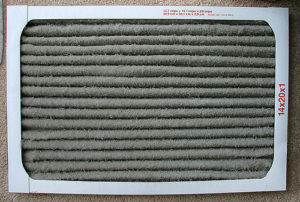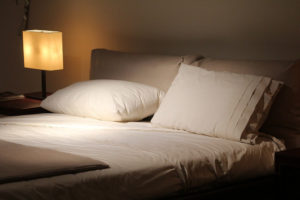
Photo from Pexels.
Before heading out into the sunshine, we know to lather up with sunscreen and pack plenty of water. But another important step is to check the ozone forecast; this is especially important for children, the elderly, those with respiratory diseases or heart disease, and asthmatics.
Ground-level Ozone
There are two types of ozone, but ground-level ozone is the one you should be concerned about. Ozone occurs naturally in the stratosphere, but ground-level ozone is created when nitrogen oxide (NOx) and volatile organic compounds (VOCs) chemically react in the sunlight. Ground-level ozone comes from sources like cars and smokestacks.
Ozone Forecast
Ground-level ozone can exacerbate asthma symptoms, but asthmatics can monitor the ozone forecast each day to know if it’s OK to participate in outdoor activities. Elaine Loyack is the program coordinator for Triangle Air Awareness, an organization that helps Triangle-area residents and businesses stay informed about and help improve local air quality. Each summer, she reminds folks about the importance of keeping tabs on the local ozone forecast and to plan their outdoor activity level accordingly.
“Ozone forecast season is the time of the year when the risk for unhealthy levels of ground-level ozone formation is highest,” says Elaine. “In North Carolina, ozone forecast season runs from April 1-October 31.”
What the Ozone Forecast Means for Asthmatics
On unhealthy air quality days, asthmatics should limit time outdoors to the morning and early to late evening. Severe asthma sufferers should avoid the outdoors completely. Asthmatics should also reduce their level of activity, so if you normally run outside, choose a walk instead.
- Code Yellow (Moderate)–dangerous for those suffering extreme asthma.
- Code Orange (Unhealthy for Sensitive Groups), Code Red (Unhealthy), and Code Purple (Very Unhealthy)–dangerous for all asthma sufferers.
Ozone Forecast Resources
Asthmatics can monitor ozone levels by email, phone, the Internet, social media, and through a mobile app. Each day at 3pm, the ozone forecast is published for the following day so folks can plan ahead. Click here to sign up to receive the ozone forecast.
 Lack of sleep can cause more than dark under eye circles and a surly demeanor. Some more well-known risks from insufficient sleep are increased risk of stroke, obesity and diabetes, anxiety and depression, and heart disease. A new study by Taiwanese researchers showed that another obstructive sleep apnea (OSA) comorbidity is osteoporosis.
Lack of sleep can cause more than dark under eye circles and a surly demeanor. Some more well-known risks from insufficient sleep are increased risk of stroke, obesity and diabetes, anxiety and depression, and heart disease. A new study by Taiwanese researchers showed that another obstructive sleep apnea (OSA) comorbidity is osteoporosis.















 Part I: How to Lessen Asthma Symptoms by Addressing Indoor Air Quality, I explained how improving indoor air quality with the right air filters is key to managing asthma symptoms. In Part II of this series, you’ll learn how to manage indoor humidity levels to prevent mold growth.
Part I: How to Lessen Asthma Symptoms by Addressing Indoor Air Quality, I explained how improving indoor air quality with the right air filters is key to managing asthma symptoms. In Part II of this series, you’ll learn how to manage indoor humidity levels to prevent mold growth. Vacuuming with a HEPA vacuum cleaner, dusting, and regularly changing bedding are all important steps to take care of allergens in your home. Asthma sufferers should also frequently change return air filters in their HVAC system to capture particulates; monitoring humidity levels in the home to manage mold is also beneficial.
Vacuuming with a HEPA vacuum cleaner, dusting, and regularly changing bedding are all important steps to take care of allergens in your home. Asthma sufferers should also frequently change return air filters in their HVAC system to capture particulates; monitoring humidity levels in the home to manage mold is also beneficial. There’s a lot more than stuffing and springs in your mattress, it can also be home to dust mites and other allergens like pet dander and mold. Although dust mites are invisible to the naked eye, these critters can exacerbate asthma symptoms and shouldn’t be ignored. About a quarter of Americans have allergies, and two-thirds of that group have
There’s a lot more than stuffing and springs in your mattress, it can also be home to dust mites and other allergens like pet dander and mold. Although dust mites are invisible to the naked eye, these critters can exacerbate asthma symptoms and shouldn’t be ignored. About a quarter of Americans have allergies, and two-thirds of that group have 
 It’s common knowledge that regular aerobic exercise reduces the risk of diabetes, but a recent study revealed strength training, or anaerobic exercise, also reduces the risk of Type 2 diabetes in women.
It’s common knowledge that regular aerobic exercise reduces the risk of diabetes, but a recent study revealed strength training, or anaerobic exercise, also reduces the risk of Type 2 diabetes in women.  In early spring I don’t even bother washing my car; I’ve given up on the fight with the yellow-green pine pollen. Although few people are
In early spring I don’t even bother washing my car; I’ve given up on the fight with the yellow-green pine pollen. Although few people are 
 A season normally filled with joy can turn miserable quickly. Seasonal allergic rhinitis and asthma sufferers can breathe relief as most outdoor allergens disappear until spring, but holiday gatherings and increased time spent indoors means more exposure to different allergen triggers. In an effort to help you avoid the hazards of the holidays, we’ve compiled some tips to keep you from wheezing and sneezing.
A season normally filled with joy can turn miserable quickly. Seasonal allergic rhinitis and asthma sufferers can breathe relief as most outdoor allergens disappear until spring, but holiday gatherings and increased time spent indoors means more exposure to different allergen triggers. In an effort to help you avoid the hazards of the holidays, we’ve compiled some tips to keep you from wheezing and sneezing. Asthma is a prevalent disease among children, accounting for numerous emergency room visits, and unfortunately, a significant cause of morbidity. Although asthma incidence has increased over the past few decades, variations between countries, environmental factors and the use of certain medications have created a flurry of research dedicated to the disease and the understanding of its etiology.
Asthma is a prevalent disease among children, accounting for numerous emergency room visits, and unfortunately, a significant cause of morbidity. Although asthma incidence has increased over the past few decades, variations between countries, environmental factors and the use of certain medications have created a flurry of research dedicated to the disease and the understanding of its etiology. 









